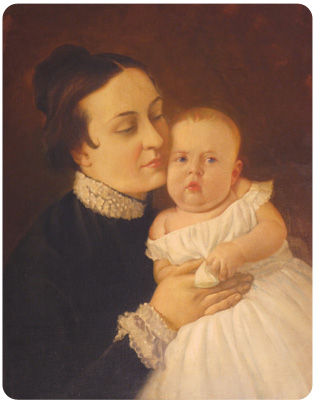 with Eugene Filed as a baby, ca 1850 with Eugene Filed as a baby, ca 1850
Eugene Field House
Portrait Description
A woman holds a baby in her arms, resting her face against his chubby cheek as if she is about to kiss him. Although the baby wears a dress, it is a boy. Neatly dressed with ruffled trim on collar and cuffs, the woman looks down at the child with an almost serene expression. His bright eyes look forward; fabric is clutched in his tiny fingers. This portrait shows Frances Maria Reed Field with her eldest surviving son, Eugene Field, as a baby. The portrait was painted by an unknown artist in either 1850 or 1851. This is one of the few surviving picture of Eugene Field and his mother, as Frances would pass away when he was only six.
Wife, Mother, and Educated Woman
The daughter of a professional musician, Frances Maria Reed grew up in Wyndham County, Vermont. After attending Mount Holyoke Female Seminary, Frances moved to St. Louis to be a teacher. She met a young attorney, Roswell Martin Field, who would be remembered in history for his pivotal role in the Dred Scott case. Ironically, Roswell was also from Windham County, Vermont. They married in 1848. Following the death of their son Theodore in the cholera epidemic of 1849, Frances and Roswell rented a unit in Walsh’s Row, about a mile outside of downtown. Frances would have a total of five children. Two sons, Eugene and Roswell Jr., would survive. Frances died in November 1856, a few months after her baby daughter passed away. Although Eugene was only six when his mother died, he remembers her through his writing—in a poem “To My Mother” and his “Sharps and Flats” column on October 25, 1890, thirty-four years after her death.
Frances Field is described as charming with a strong character and a firm mind. In other sources, she is also characterized as quiet and refined, sweet and gentle. Memorialized by Eugene, his poem recalls her dark eyes and “beauteous face” that also references a “grace of long ago.”
Women’s Education in the Antebellum Era
Frances attended Mount Holyoke Female Seminary, today known as Mount Holyoke College. By 1861 the three-year curriculum was expanded to four, and by 1893 the seminary curriculum was phased out and it was renamed as a college. Women’s education in America reaches back to the colonial era—a multitude of schools for women were established between 1820 and 1860. In 1836, Georgia Female College, later Wesleyan University, was the first school to be chartered specifically as a women’s college. Ohio’s Oberlin College was the first to become coeducational when it admitted four women in 1837. Women’s degrees were typically seen as a lesser degree than those earned by men. Schools had strict rules—Mount Holyoke stated that “young ladies are not allowed to stand in the doorway” and “we never examine young ladies in Algebra.”
Many women students used their degrees to become teachers, as did Frances. In some respects, Frances was an early trailblazer receiving extensive education when few women did. But she, and most of her classmates, also fulfilled the traditional role of a Victorian woman.
top^
next artifact}
|

|




